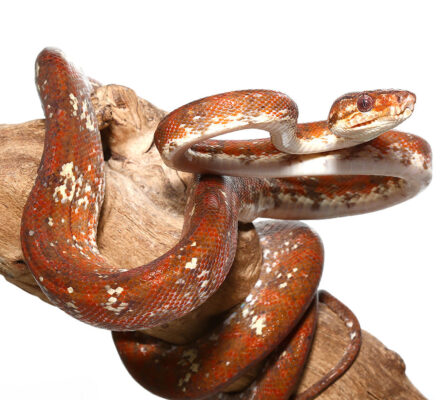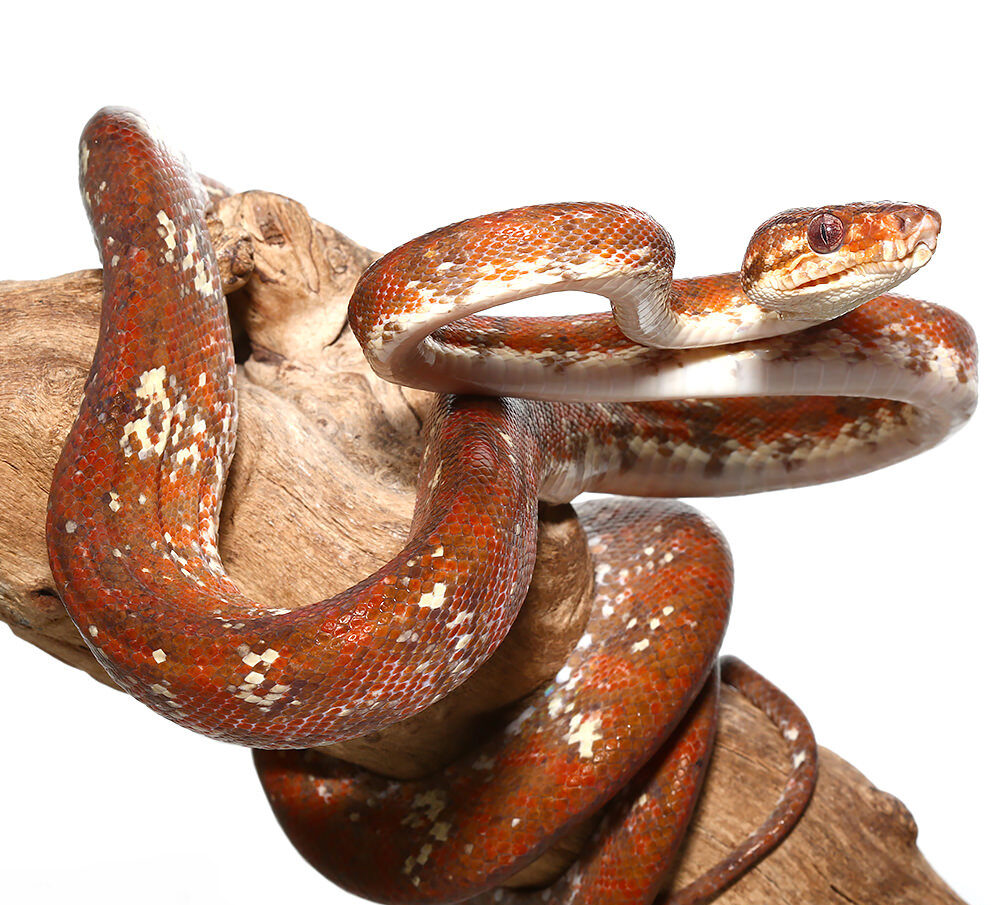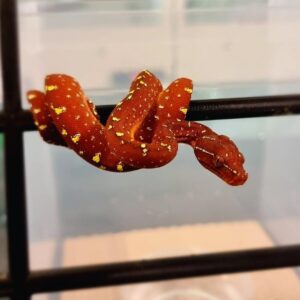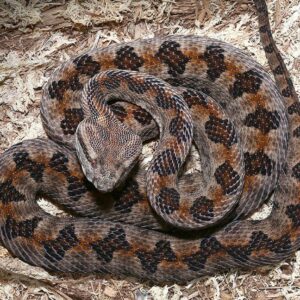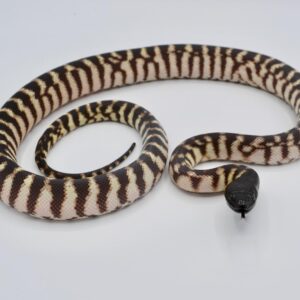High White Calico Amazon Tree Boa For Sale
$1,499.99
WE HAVE AN ADULT HIGH WHITE CALICO AMAZON TREE BOA FOR SALE. HERE ARE SOME HIGHLIGHTS:
- Corallus hortulanus
- Field Collected
- Approximately 4 Feet In Length
- Adults Will Grow Up To 4 – 6 Feet In Length From Head To Tail
- Feeding On Frozen/Thawed Or Live Pinky Mice Weekly
FUN FACTS!
- Arboreal Species Requiring High Humidity And Daily Misting
- Originating From The Amazon, Ranging Central Venezuela, Eastern Colombia And Guyana
- This Species Is Known For Being Feisty But Is Easy To Handle With A Snake Hook
- With Proper Care And Set Up They Can Live Up To 12 – 20 Years In Captivity
Description
The High White Calico Amazon Tree Boa is an extraordinary species, distinguished by its striking appearance and unique patterns that set it apart from other members of the boa family. Hailing from the lush, tropical rainforests of the Amazon Basin, this particular boa showcases a predominantly white coloration, interspersed with intricate calico patterns that can range from subtle speckles to bold patches of contrasting hues.
One of the most defining features of the High White Calico Amazon Tree Boa is its vibrant and varied palette. The base white coloration is often complemented by shades of black, gray, or even hints of yellow and orange. This vivid display not only makes it a visually captivating species but also aids in its camouflage within the dappled light of its arboreal habitat. The mesmerizing patterns are a result of complex genetic variations, making each individual boa uniquely beautiful.
Apart from its visual appeal, the High White Calico Amazon Tree Boa is also notable for its slender, elongated body, which is well-adapted for an arboreal lifestyle. It possesses a prehensile tail that aids in climbing and navigating through the dense foliage of the rainforest. Typically, this species reaches lengths of 5 to 7 feet, with a graceful, agile form that allows it to move effortlessly among the trees.
In addition to its physical characteristics, the High White Calico Amazon Tree Boa is known for its nocturnal behavior and a diet primarily composed of small mammals, birds, and occasionally reptiles. Its hunting strategy involves remaining motionless and blending into its surroundings until the opportune moment to strike at unsuspecting prey.
Understanding the unique attributes of the High White Calico Amazon Tree Boa is crucial for enthusiasts and researchers alike. This introduction sets the stage for a deeper exploration into the biology, habitat, and care requirements of this fascinating species, offering valuable insights into what makes the High White Calico Amazon Tree Boa a standout member of the reptile world.
Natural Habitat and Distribution
The High White Calico Amazon Tree Boa, scientifically known as Corallus hortulanus, is predominantly found in the lush and biodiverse regions of the Amazon rainforest. This species thrives in the dense, humid environments that characterize the Amazon Basin, stretching across countries such as Brazil, Peru, Ecuador, Colombia, and Venezuela. These boas are arboreal, meaning they spend much of their time in the trees, which provide both a rich hunting ground and a safe haven from predators.
The Amazon rainforest offers an ideal setting for the High White Calico Amazon Tree Boa due to its consistent warm temperatures and high humidity levels. These environmental conditions are crucial for the boa’s survival, as they support its thermoregulation and hydration needs. The intricate network of trees and foliage in the rainforest canopy provides ample opportunities for these boas to exhibit their climbing prowess and hunting skills, primarily preying on small mammals, birds, and occasionally other reptiles.
One notable aspect of the High White Calico Amazon Tree Boa’s habitat is the diversity of microenvironments it can adapt to within the broader rainforest ecosystem. From the thick, leafy upper canopy to the more sparse understory, these boas are highly adaptable and can be found at various elevations within the forest. Their ability to camouflage effectively with their surroundings helps them avoid predators and enhances their hunting efficiency.
The natural habitat of the High White Calico Amazon Tree Boa significantly influences its behavior and physical traits. The boa’s distinctive high white calico pattern not only provides excellent camouflage but also plays a role in thermoregulation by reflecting sunlight. The humid environment supports their skin health and shedding process, which is essential for growth and overall well-being. Additionally, the arboreal lifestyle fosters their agility and strength, making them adept climbers and efficient hunters.
Physical Characteristics and Morphology
The High White Calico Amazon Tree Boa is renowned for its striking and unique appearance. One of the primary physical attributes of this morph is its size, with adult boas typically reaching lengths of 5 to 7 feet. The body is long and slender, which is a common characteristic among Amazon Tree Boas, allowing for agile movement through the arboreal habitats they prefer. The musculature is well-developed, providing the necessary strength for climbing and constricting prey.
The skin texture of the High White Calico Amazon Tree Boa is smooth and supple, with scales that are fine and overlap neatly. This smooth texture aids in both movement through trees and shedding. The coloration of this morph is what truly sets it apart. The “high white” aspect refers to the presence of significant white patches or scales that contrast sharply with the darker base colors, which can range from deep browns and blacks to vibrant reds and oranges. This calico pattern is not uniform, resulting in a unique appearance for each individual boa.
In comparison to other Amazon Tree Boa morphs, the High White Calico stands out due to its distinctive and dramatic color contrasts. While other morphs may exhibit more uniform or muted color patterns, the High White Calico’s irregular, high-contrast patches provide a visually striking appearance. This morph’s pattern is highly sought after by enthusiasts and breeders alike due to its rarity and aesthetic appeal.
Overall, the High White Calico Amazon Tree Boa’s physical characteristics—its size, body shape, skin texture, and especially its unique coloring—make it a fascinating subject for herpetologists and reptile enthusiasts. Understanding these attributes not only helps in identifying this particular morph but also adds to the appreciation of the diversity within the Amazon Tree Boa species.
Behavior and Temperament
The High White Calico Amazon Tree Boa is known for its distinctive behavior and unique temperament, making it a fascinating subject for herpetology enthusiasts. These boas are primarily nocturnal, showcasing peak activity during the night. They exhibit a high level of curiosity and agility, often seen exploring their surroundings with meticulous precision. This nocturnal lifestyle means they spend most of the day resting, camouflaged within the foliage or other secluded spots.
When it comes to feeding habits, the High White Calico Amazon Tree Boa is a proficient hunter. In the wild, their diet primarily consists of small mammals and birds, which they ambush from their arboreal perches. In captivity, they readily accept pre-killed or frozen-thawed rodents. Feeding should be done with caution, as these boas can exhibit a strong feeding response. It’s essential to maintain a consistent feeding schedule to ensure their health and well-being.
One notable trait of the High White Calico Amazon Tree Boa is its defensive behavior. When threatened, they may exhibit a defensive posture, hissing loudly and striking if provoked. However, with regular, gentle handling, they can become more accustomed to human interaction, though they are generally known to be more temperamental compared to other boa species. It is important for keepers to respect their space and approach them calmly to minimize stress.
In their natural habitat, these boas interact with their environment by utilizing the dense foliage for both hunting and protection. They are solitary creatures, coming together only during the breeding season. Their interactions with other species are limited to predation and competition for resources. Understanding these behavioral nuances is crucial for anyone looking to keep a High White Calico Amazon Tree Boa, as it helps in creating an environment that mimics their natural habitat, promoting their overall health and well-being.
Diet and Feeding Requirements
The High White Calico Amazon Tree Boa (Corallus hortulanus) is a fascinating species with specific dietary needs that differ based on whether they are in the wild or captivity. Understanding these requirements is crucial for their health and well-being.
In their natural habitat, these boas primarily feed on small mammals, birds, and sometimes lizards. Their diet is opportunistic, meaning they will consume prey that is readily available. They are nocturnal hunters, using their keen sense of smell and heat-sensing pits to locate and capture prey during the night. Rodents and small birds constitute the bulk of their diet in the wild, providing them with essential proteins and nutrients necessary for their growth and energy needs.
When kept in captivity, the dietary needs of the High White Calico Amazon Tree Boa must be carefully managed to mimic their natural intake. The most common prey items offered to captive boas are appropriately sized mice and rats. Juvenile boas should be fed smaller prey items, such as pinkie mice, gradually increasing the size of the prey as the snake grows. Adult boas can consume larger prey, such as adult mice or small rats, every 10 to 14 days. It is vital to ensure that the prey size is proportional to the snake’s girth, typically no larger than 1.5 times the width of the snake’s body.
To ensure a balanced and nutritious diet, it is recommended to occasionally vary the types of prey offered. This can include small quail or chicks to provide a varied nutrient profile. Additionally, it is beneficial to supplement the prey with vitamins and minerals occasionally, particularly calcium, to support bone health and overall vitality.
Feeding frequency is another crucial aspect to consider. Juveniles generally require more frequent feeding, approximately every 5 to 7 days, due to their rapid growth rates. As boas mature, their metabolic rate slows, and their feeding frequency can be reduced. Care should be taken not to overfeed, as obesity can lead to serious health issues in captive snakes.
Proper hydration is also essential. Fresh water should be available at all times, and it is advisable to provide a shallow water dish for drinking and soaking. Regular monitoring of feeding habits and adjusting the diet as necessary will help maintain the health and longevity of the High White Calico Amazon Tree Boa in captivity.
Housing and Environmental Needs
Creating an ideal living environment for the High White Calico Amazon Tree Boa is essential for its health and well-being. The enclosure size is a critical factor; a minimum of a 20-gallon tall terrarium is recommended for a single adult boa. Given the arboreal nature of this species, height is more important than length or width. A vertical space of at least 36 inches is ideal, allowing the boa to climb and exhibit its natural behaviors.
Temperature and humidity are pivotal in maintaining the health of the High White Calico Amazon Tree Boa. The ambient temperature should be maintained between 75°F and 85°F, with a basking spot around 90°F. Nighttime temperatures can safely drop to around 70°F. Humidity levels should be kept consistently between 60% and 80%. This can be achieved through regular misting and the use of a substrate that retains moisture well, such as cypress mulch or sphagnum moss.
Providing climbing structures and hiding spots is crucial for the mental and physical stimulation of the boa. Branches, vines, and other vertical elements should be incorporated into the enclosure to mimic their natural habitat. Additionally, hiding spots at various heights offer security and reduce stress, which is vital for their overall health.
Regular enclosure maintenance is another key aspect of caring for the High White Calico Amazon Tree Boa. The enclosure should be cleaned weekly, with spot cleaning done as needed to remove waste and uneaten food. Ensuring a clean environment helps in preventing health issues such as respiratory infections and parasitic infestations.
In summary, the proper housing and environmental conditions are essential for the well-being of the High White Calico Amazon Tree Boa. By providing an appropriately sized enclosure, maintaining the correct temperature and humidity levels, and ensuring the availability of climbing structures and hiding spots, owners can create a habitat that promotes the health and longevity of this captivating species.
Health and Common Issues
The High White Calico Amazon Tree Boa, like any other reptile, is susceptible to a variety of health issues that owners should be aware of. Recognizing the signs of illness early can make a significant difference in the successful treatment and overall well-being of your boa.
One of the most common health problems in these boas is respiratory infections. Symptoms may include wheezing, open-mouth breathing, and excessive mucus around the nostrils or mouth. If you observe any of these signs, it’s crucial to consult a veterinary professional promptly. Another frequent issue is parasitic infestations, both internal and external. Look for signs such as lethargy, unusual feces, and visible mites on the skin. Regular health checks, including fecal exams, can help detect and manage these parasites effectively.
Proper husbandry practices are essential in preventing many health problems. Ensuring that the enclosure maintains the correct temperature and humidity levels is vital. High White Calico Amazon Tree Boas thrive in environments that mimic their natural habitat, with temperatures ranging from 75°F to 85°F and humidity levels between 60% and 80%. Improper conditions can lead to dehydration, shedding problems, and stress, which in turn can make the boa more susceptible to illnesses.
Routine health checks should be a part of your care regimen. Monitor your snake’s eating habits, weight, and overall appearance regularly. If you notice any significant changes, it may be an indication of an underlying health issue. It’s also important to establish a relationship with a qualified reptile veterinarian who has experience with Amazon Tree Boas. They can provide you with invaluable advice on preventive care and be a crucial resource if your boa becomes ill.
In summary, being proactive in monitoring your High White Calico Amazon Tree Boa’s health, maintaining optimal living conditions, and consulting with a reptile veterinarian can significantly reduce the likelihood of health issues and ensure your boa leads a healthy and vibrant life.
Breeding and Reproduction
The High White Calico Amazon Tree Boa exhibits interesting and complex breeding behaviors, integral to its reproductive cycle. During the mating season, which typically occurs in the warmer months, these boas engage in unique courtship rituals. Males will often become more active, displaying increased movement and seeking out females by following scent trails. This behavior is crucial for successful mating, as it ensures that the males locate receptive females within their habitat.
Once a mating pair is established, the actual mating process can take several hours, during which the male and female intertwine. Following successful copulation, the gestation period for the High White Calico Amazon Tree Boa ranges between 150 to 180 days. Unlike many other snake species, these boas give live birth to their young rather than laying eggs. A typical litter can consist of 10 to 20 neonates, each measuring around 12 to 18 inches in length.
The care of newborn High White Calico Amazon Tree Boas is a critical aspect of their reproductive cycle. It involves providing optimal temperature and humidity levels, along with appropriate enclosures that mimic their natural environment. The neonates are initially housed separately to monitor their health and development closely. During the first few weeks, they are fed small prey items, such as pinky mice, to ensure they receive adequate nutrition for growth.
Breeding these boas in captivity presents several challenges and considerations. One of the primary concerns is maintaining genetic diversity to prevent inbreeding, which can lead to health issues and reduced vitality in offspring. Ethical breeding practices are essential to ensure the long-term sustainability of the species. Breeders must also be mindful of the legal and ethical implications of breeding and selling exotic animals, adhering to all relevant regulations and guidelines.
In conclusion, understanding the breeding and reproductive aspects of the High White Calico Amazon Tree Boa is essential for successful captive breeding programs. By ensuring proper care and ethical practices, breeders can contribute to the conservation and appreciation of this unique and fascinating species.
